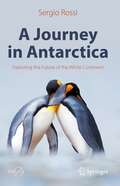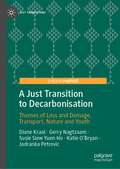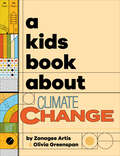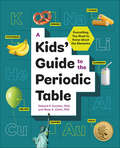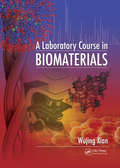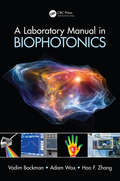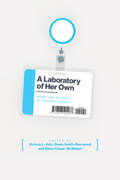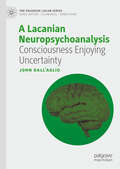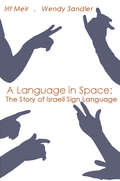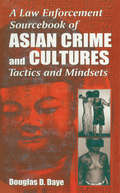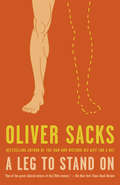- Table View
- List View
A Journey Through The Universe: A traveler's guide from the centre of the sun to the edge of the unknown (New Scientist Instant Expert)
by New ScientistThere's a whole universe out there...Imagine you had a spacecraft capable of travelling through interstellar space. You climb in, blast into orbit, fly out of the solar system and keep going. Where do you end up, and what do you see along the way?The answer is: mostly nothing. Space is astonishingly, mind-blowingly empty. As you travel through the void between galaxies your spaceship encounters nothing more exciting than the odd hydrogen molecule. But when it does come across something more exotic: wow!First and most obviously, stars and planets. Some are familiar from our own backyard: yellow suns, rocky planets like Mars, gas and ice giants like Jupiter and Neptune. But there are many more: giant stars, red and white dwarfs, super-earths and hot Jupiters. Elsewhere are swirling clouds of dust giving birth to stars, and infinitely dense regions of space-time called black holes. These clump together in the star clusters we call galaxies, and the clusters of galaxies we call... galaxy clusters.And that is just the start. As we travel further we encounter ever more weird, wonderful and dangerous entities: supernovas, supermassive black holes, quasars, pulsars, neutron stars, black dwarfs, quark stars, gamma ray bursts and cosmic strings. A Journey Through The Universe is a grand tour of the most amazing celestial objects and how they fit together to build the cosmos. As for the end of the journey - nobody knows. But getting there will be fun. ABOUT THE SERIESNew Scientist Instant Expert books are definitive and accessible entry points to the most important subjects in science; subjects that challenge, attract debate, invite controversy and engage the most enquiring minds. Designed for curious readers who want to know how things work and why, the Instant Expert series explores the topics that really matter and their impact on individuals, society, and the planet, translating the scientific complexities around us into language that's open to everyone, and putting new ideas and discoveries into perspective and context.
A Journey Through The Universe: A traveler's guide from the centre of the sun to the edge of the unknown (New Scientist Instant Expert)
by New ScientistA Journey Through The Universe is a grand tour of the most amazing celestial objects and how they fit together to build the cosmos.There's a whole universe out there...Imagine you had a spacecraft capable of travelling through interstellar space. You climb in, blast into orbit, fly out of the solar system and keep going. Where do you end up, and what do you see along the way?The answer is: mostly nothing. Space is astonishingly, mind-blowingly empty. As you travel through the void between galaxies your spaceship encounters nothing more exciting than the odd hydrogen molecule. But when it does come across something more exotic: wow!First and most obviously, stars and planets. Some are familiar from our own backyard: yellow suns, rocky planets like Mars, gas and ice giants like Jupiter and Neptune. But there are many more: giant stars, red and white dwarfs, super-earths and hot Jupiters. Elsewhere are swirling clouds of dust giving birth to stars, and infinitely dense regions of space-time called black holes. These clump together in the star clusters we call galaxies, and the clusters of galaxies we call... galaxy clusters.And that is just the start. As we travel further we encounter ever more weird, wonderful and dangerous entities: supernovas, supermassive black holes, quasars, pulsars, neutron stars, black dwarfs, quark stars, gamma ray bursts and cosmic strings. A Journey Through The Universe is a grand tour of the most amazing celestial objects and how they fit together to build the cosmos. As for the end of the journey - nobody knows. But getting there will be fun. ABOUT THE SERIESNew Scientist Instant Expert books are definitive and accessible entry points to the most important subjects in science; subjects that challenge, attract debate, invite controversy and engage the most enquiring minds. Designed for curious readers who want to know how things work and why, the Instant Expert series explores the topics that really matter and their impact on individuals, society, and the planet, translating the scientific complexities around us into language that's open to everyone, and putting new ideas and discoveries into perspective and context.(P)2018 Hodder & Stoughton Limited
A Journey in Antarctica: Exploring the Future of the White Continent (Springer Praxis Books)
by Sergio RossiHaving always been fascinated by these singular landscapes, Sergio Rossi reconstructs some of the episodes that have marked the exploration of these territories, such as the dramatic race between Amundsen and Scott to conquer the South Pole, and Captain Shackleton’s odyssey to save his crew from certain death. But also modern trips including his own to these remote areas, explaining many aspects of the current science and political competition that is underway. The book leads us on an entertaining overview of all the problems and opportunities that the planet’s most forgotten continent offers to humans. A remote mass of ice upon which our future as a species depends and which we cannot continue to ignore any longer.
A Journey into ESG Investments: The Theory and Practice of the CSR-Financial Performance Nexus (Palgrave Studies in Impact Finance)
by Giuseppe GalloppoThis book deals with climate finance and presents a balance between the theoretical framework—as drawn by the most widely cited practitioner-oriented and academic journals in environmental management—and experimental finance. Does sustainability work eventually? This book explores the data from empirical analysis to address this question. The book investigates the effectiveness of Corporate Social Responsibility and its empirical verification by analyzing the correlation between firm-specific ESG characteristics and financial performance, and will be of interest to academics, researchers, and practitioners of sustainable finance and climate finance.
A Journey into Modern Physics: From Relativity to Quantum Technologies
by Carmine GranataThis book offers a short journey into the surprising and spectacular world of modern physics characterized by disruptive ideas and theory from both a conceptual and applicative point of view. Starting from Einstein's theory of relativity in which the concepts of space, time, and gravity are completely revised, before arriving at the bizarre and fascinating universe of quantum physics which with its applications has completely changed our way of life. Particular attention is also paid to the conceptual foundations and paradoxes of quantum mechanics thanks to which the so-called second quantum revolution has developed in more recent times, destined to introduce a new generation of quantum technologies such as computers, cryptography, and teleportation into our lives. In addition to new quantum technologies, the operating principles of the most important applications of quantum mechanics which have become widespread in everyday life are illustrated simply and concisely. The book has an essentially informative character, without making use of complicated formulas or technicalities, therefore it does not require in-depth knowledge of physics or mathematics; the knowledge acquired in high school is sufficient to understand the topics covered.
A Journey through the Universe
by Ian MorisonProviding an in-depth understanding both for general readers and astronomy enthusiasts, this highly comprehensive book provides an up-to-date survey of our knowledge of the Universe beyond Earth. The book explores our Solar System, its planets and other bodies; examines the Sun and how it and other stars evolve through their lifetimes; discusses the search for planets beyond our Solar System and how we might detect life on them; and highlights interesting objects found within our galaxy, the Milky Way. It also looks at our current understanding of the origin and evolution of the Universe, as well as many other intriguing topics, such as time, black holes and Einstein's theories, dark matter, dark energy and the Cosmic Microwave Background. The book is uniquely supported by video lectures given by the author, available online. It also includes the very latest astronomical observations, such as those made by the Planck and Kepler spacecraft.
A Just Transition to Decarbonisation: Themes of Loss and Damage, Transport, Nature and Youth (Just Transitions)
by Gerry Nagtzaam Jadranka Petrovic Diane Kraal Katie O’Bryan Susie Siew HoThis book provides researchers and policy-makers with legal avenues to enable a just transition to decarbonisation. The focus is on the United Nations themes of loss and damage, transport, nature and youth - across Australia and other economies - to significantly reduce CO2 emissions by 2030 and beyond. The four themes scaffold discussions about a just transition beyond the UN Climate Change Conference COP28 in Dubai with the specific issues addressed in this book serving as a starting point for future discussions.
A Kids Book About Climate Change: Kids Are Ready (A Kids Book)
by Zanagee Artis Olivia GreenspanExplore the impact of climate change and empower kids to be proactive to protect our world.This is a kid's book about climate change. Climate change is a topic that can be overwhelming for kids and grownups. So if you're looking for the best place to better understand the climate crisis, look no further!This book helps kids aged 5-9 understand what climate change means, giving them the power to make a difference. Learn the facts about climate change, explain what the state of our planet is, how it got there, and give them hope to fight for their future.A Kids Book About Climate Change features: - A large and bold, yet minimalist font design that allows kids freedom to imagine themselves in the words on the pages.- A friendly, approachable and empowering, kid-appropriate tone throughout.- An incredible and diverse group of authors in the series who are experts or have first-hand experience of the topic.Tackling important discourse together! The A Kids Book About series are best used when read together. Helping to kickstart challenging, empowering, and important conversations for kids and their grownups through beautiful and thought-provoking pages. The series supports an incredible and diverse group of authors, who are either experts in their field, or have first-hand experience on the topic. A Kids Co. is a new kind of media company enabling kids to explore big topics in a new and engaging way. With a growing series of books, podcasts and blogs, made to empower. Learn more about us online by searching for A Kids Co.
A Kids Book About Nervous System Regulation (A Kids Book)
by Dr. Joy Malik-HasbrookLearn about the importance of nervous system regulation and how it helps to make us feel safe and connected – with each other and within ourselves.This is a kids’ book about nervous system regulation. The nervous system guides so much of what we do, from breathing and feeling to thinking and living! But our nervous systems can get dysregulated, which can make us feel disconnected or overwhelmed. This book was made to help kids aged 5-9 understand different stress responses and practice techniques to calm and regulate our nervous systems – all parts of being human!A Kids Book About Nervous System Regulation features: A large and bold, yet minimalist font design that allows kids freedom to imagine themselves in the words on the pages.A friendly, approachable, empowering and child-appropriate tone throughout.An incredible and diverse group of authors in the series who are experts or have first-hand experience of the topic.Tackling important discourse together! The A Kids Book About titles are best used when read together. Helping to kickstart important, challenging, and empowering conversations for kids and their grown-ups through beautiful and thought-provoking pages. The series supports an incredible and diverse group of authors, who are either experts in their field, or have first-hand experience on the topic. A Kids Co. is a new kind of media company enabling kids to explore big topics in a new and engaging way, with a growing series of books, podcasts and blogs made to empower. Learn more about us online by searching for A Kids Co.
A Kids' Guide to the Periodic Table: Everything You Need to Know about the Elements
by Edward P. Zovinka Rose A. ClarkFrom aluminum to zinc—make it fun for kids 8 to 12 to discover all 118 elements on the periodic table!Discover the building blocks of the entire world! A Kids' Guide to the Periodic Table takes you on an incredible journey through history and science that will teach you all about the 118 elements that make up, well, everything!Go in-depth with awesome profiles on each and every element that provide all their important elemental stats (like their atomic number, state, group, and more), as well as awesome facts about the element and its discovery. Take what you know about science—and the world—to a new level as you discover what makes the periodic table of elements so amazing.A Kids' Guide to the Periodic Table includes:The periodic table explained—Learn about the creation of the periodic table and get tons of info to help you understand the groups, the order of elements, and more.Amazing discoveries—Explore how elements like neon, helium, and californium were discovered, as well as what they've helped scientists do.Fun for you—Find out how exciting science can be with an entertaining look into all the ways the elements affect your everyday life.A fun, fact-filled science adventure awaits you with A Kids' Guide to the Periodic Table!
A Kinetic View of Statistical Physics
by Pavel L. Krapivsky Sidney Redner Eli Ben-NaimAimed at graduate students, this book explores some of the core phenomena in non-equilibrium statistical physics. It focuses on the development and application of theoretical methods to help students develop their problem-solving skills. The book begins with microscopic transport processes: diffusion, collision-driven phenomena, and exclusion. It then presents the kinetics of aggregation, fragmentation and adsorption, where the basic phenomenology and solution techniques are emphasized. The following chapters cover kinetic spin systems, both from a discrete and a continuum perspective, the role of disorder in non-equilibrium processes, hysteresis from the non-equilibrium perspective, the kinetics of chemical reactions, and the properties of complex networks. The book contains 200 exercises to test students' understanding of the subject. A link to a website hosted by the authors, containing supplementary material including solutions to some of the exercises, can be found at www. cambridge. org/9780521851039.
A Kitchen Course in Electricity and Magnetism
by David Nightingale Christopher SpencerElectricity is all around us: cars, telephones, computers, lights -- the modern world runs entirely on electrons. But what are electrons? How do they behave? How do we control them? This book will show you how to build a battery, detect static electricity and construct a basic current meter, all using common items from your kitchen. Along the way you'll learn about the meaning of "voltage" and "current", what makes an LED work and the difference between AC and DC. The last chapter uses transistors -- the basic building blocks of every computer -- for lots of interesting experiments. With plenty of colorful illustrations, historical stories and an easy, accessible style, "A Kitchen Course in Electricity and Magnetism" will be a great start for budding and amateur scientists who want to learn more about how the world works.
A Lab for All Seasons: The Laboratory Revolution in Modern Botany and the Rise of Physiological Plant Ecology
by Sharon E. KingslandThe first book to chronicle how innovation in laboratory designs for botanical research energized the emergence of physiological plant ecology as a vibrant subdiscipline Laboratory innovation since the mid-twentieth century has powered advances in the study of plant adaptation, evolution, and ecosystem function. The phytotron, an integrated complex of controlled-environment greenhouse and laboratory spaces, invented by Frits W. Went in the 1950s, set off a worldwide laboratory movement and transformed the plant sciences. Sharon Kingsland explores this revolution through a comparative study of work in the United States, France, Australia, Israel, the USSR, and Hungary. These advances in botanical research energized physiological plant ecology. Case studies explore the development of phytotron spinoffs such as mobile laboratories, rhizotrons, and ecotrons. Scientific problems include the significance of plant emissions of volatile organic compounds, symbiosis between plants and soil fungi, and the discovery of new pathways for photosynthesis as an adaptation to hot, dry climates. The advancement of knowledge through synthesis is a running theme: linking disciplines, combining laboratory and field research, and moving across ecological scales from leaf to ecosystem. The book also charts the history of modern scientific responses to the emerging crisis of food insecurity in the era of global warming.
A Lab of One's Own: One Woman's Personal Journey Through Sexism in Science
by Rita Colwell Sharon Bertsch McGrayneA riveting memoir-manifesto from the first female director of the National Science Foundation about the entrenched sexism in science, the elaborate detours women have taken to bypass the problem, and how to fix the system. If you think sexism thrives only on Wall Street or in Hollywood, you haven&’t visited a lab, a science department, a research foundation, or a biotech firm. Rita Colwell is one of the top scientists in America: the groundbreaking microbiologist who discovered how cholera survives between epidemics and the former head of the National Science Foundation. But when she first applied for a graduate fellowship in bacteriology, she was told, &“We don&’t waste fellowships on women.&” A lack of support from some male superiors would lead her to change her area of study six times before completing her PhD. A Lab of One&’s Own documents all Colwell has seen and heard over her six decades in science, from sexual harassment in the lab to obscure systems blocking women from leading professional organizations or publishing their work. Along the way, she encounters other women pushing back against the status quo, including a group at MIT who revolt when they discover their labs are a fraction of the size of their male colleagues&’. Resistance gave female scientists special gifts: forced to change specialties so many times, they came to see things in a more interdisciplinary way, which turned out to be key to making new discoveries in the twentieth and twenty-first centuries. Colwell would also witness the advances that could be made when men and women worked together—often under her direction, such as when she headed a team that helped to uncover the source of the anthrax used in the 2001 letter attacks. A Lab of One&’s Own shares the sheer joy a scientist feels when moving toward a breakthrough, and the thrill of uncovering a whole new generation of female pioneers. But it is also the science book for the #MeToo era, offering an astute diagnosis of how to fix the problem of sexism in science—and a celebration of the women pushing back.
A Laboratory Course in Biomaterials
by Wujing XianThe field of biomedical engineering has vastly expanded in the past two decades, as reflected in the increased number of bioengineering and biomaterials programs at universities. The growth of this area has outpaced the development of laboratory courses that allow students hands-on experience, since the barriers involved in creating multidisciplina
A Laboratory Course in Nanoscience and Nanotechnology
by Gerrard Eddy PoinernAlthough there are many theoretical nanotechnology and nanoscience textbooks available to students, there are relatively few practical laboratory-based books. Filling this need, A Laboratory Course in Nanoscience and Nanotechnology presents a hands-on approach to key synthesis techniques and processes currently used in nanotechnology and nanoscienc
A Laboratory Course in Tissue Engineering
by Melissa Kurtis Micou Dawn KilkennyFilling the need for a lab textbook in this rapidly growing field, A Laboratory Course in Tissue Engineering helps students develop hands-on experience. The book contains fifteen standalone experiments based on both classic tissue-engineering approaches and recent advances in the field. Experiments encompass a set of widely applicable techniques: c
A Laboratory Manual in Biophotonics
by Vadim Backman Adam Wax Hao F. ZhangBiophotonics is a burgeoning field that has afforded researchers and medical practitioners alike an invaluable tool for implementing optical microscopy. Recent advances in research have enabled scientists to measure and visualize the structural composition of cells and tissue while generating applications that aid in the detection of diseases such as cancer, Alzheimer’s, and atherosclerosis. Rather than divulge a perfunctory glance into the field of biophotonics, this textbook aims to fully immerse senior undergraduates, graduates, and research professionals in the fundamental knowledge necessary for acquiring a more advanced awareness of concepts and pushing the field beyond its current boundaries. The authors furnish readers with a pragmatic, quantitative, and systematic view of biophotonics, engaging such topics as light-tissue interaction, the use of optical instrumentation, and formulating new methods for performing analysis. Designed for use in classroom lectures, seminars, or professional laboratories, the inclusion and incorporation of this textbook can greatly benefit readers as it serves as a comprehensive introduction to current optical techniques used in biomedical applications. Caters to the needs of graduate and undergraduate students as well as R&D professionals engaged in biophotonics research. Guides readers in the field of biophotonics, beginning with basic concepts before proceeding to more advanced topics and applications. Serves as a primary text for attaining an in-depth, systematic view of principles and applications related to biophotonics. Presents a quantitative overview of the fundamentals of biophotonic technologies. Equips readers to apply fundamentals to practical aspects of biophotonics.
A Laboratory of Her Own: Women and Science in Spanish Culture
by Victoria L. Ketz, Dawn Smith-Sherwood, and Debra Faszer-McmahonA Laboratory of Her Own gathers diverse voices to address women's interaction with STEM fields in the context of Spanish cultural production. This volume focuses on the many ways the arts and humanities provide avenues for deepening the conversation about how women have been involved in, excluded from, and represented within the scientific realm. While women's historic exclusion from STEM fields has been receiving increased scrutiny worldwide, women within the Spanish context have been perhaps even more peripheral given the complex sociocultural structures emanating from gender norms and political ideologies dominant in nineteenth- and twentieth-century Spain. Nonetheless, Spanish female cultural producers have long been engaged with science and technology, as expressed in literature, art, film, and other genres. Spanish arts and letters offer diverse representations of the relationships between women, gender, sexuality, race, and STEM fields.A Laboratory of Her Own studies representations of a diverse range of Spanish women and scientific cultural products from the late nineteenth through the twenty-first centuries. STEM topics include the environment, biodiversity, temporal and spatial theories, medicine and reproductive rights, neuroscience, robotics, artificial intelligence, and quantum physics. These scientific themes and other issues are analyzed in narratives, paintings, poetry, photographs, science fiction, medical literature, translation, newswriting, film, and other forms.
A Lacanian Neuropsychoanalysis: Consciousness Enjoying Uncertainty (The Palgrave Lacan Series)
by John Dall’AglioThis book brings together Lacanian psychoanalysis, neuropsychoanalytic work by Mark Solms and Ariane Bazan, Jaak Panksepp’s affective neuroscience, Karl Friston’s free energy principle, Adrian Johnston’s transcendental materialist philosophy, and Darian Leader’s critique of jouissance in Lacanian theory. In doing so, it articulates a philosophical and scientific basis for Lacanian neuropsychoanalysis. A Lacanian perspective on Solms’s recent neuropsychoanalytic developments in affective consciousness and predictive coding furnishes an immanent critique that advances both Lacanian psychoanalysis and neuropsychoanalysis. Dall’Aglio develops novel propositions for conceptualizing the Lacanian real, symbolic, and imaginary registers in the brain, treating affect systems like signifiers, viewing jouissance as surplus prediction error, and conceiving the brain as structurally antagonistic. It presents fresh theoretical and clinical insights in a manner that will be accessible to the interdisciplinary fields it draws upon. It will appeal to those working in neuropsychoanalysis, clinical psychology, neuroscience, psychoanalysis, and critical theory.
A Language in Space: The Story of Israeli Sign Language
by Irit Meir Wendy SandlerThis English version of A Language in Space: The Story of Israeli Sign Language, which received the Bahat Award for most outstanding book for a general audience in its Hebrew edition, is an introduction to sign language using Israeli Sign Language (ISL) as a model. Authors Irit Meir and Wendy Sandler offer a glimpse into a number of fascinatin
A Law Enforcement Sourcebook of Asian Crime and CulturesTactics and Mindsets
by Douglas D. DayeEven in multicultural North America, few whites, blacks, or Hispanics have extensive experience or understanding of Asian culture. For experienced police officers, intelligence analysts, correctional officers, and prosecutors, the problems of cultural differences in behavior remain complex and problematic. This book addresses these specific law enforcement problems, and supplies law enforcement professionals with information and strategies for easier arrests, more accurate intelligence, more successful prosecutions, and fewer problems during incarceration.
A Leg to Stand On
by Oliver SacksDr. Oliver Sacks&’s books Awakenings, An Anthropologist on Mars, and the bestselling The Man Who Mistook His Wife for a Hat have been acclaimed for their extraordinary compassion in the treatment of patients affected with profound disorders. In A Leg to Stand On, it is Sacks himself who is the patient: an encounter with a bull on a desolate mountain in Norway has left him with a severely damaged leg. But what should be a routine recuperation is actually the beginning of a strange medical journey when he finds that his leg uncannily no longer feels like part of his body. Sacks&’s brilliant description of his crisis and eventual recovery is not only an illuminating examination of the experience of patienthood and the inner nature of illness and health but also a fascinating exploration of the physical basis of identity. This 1984 classic is now available in an expanded edition with a new foreword, written by Kate Edgar, executive director of the Oliver Sacks Foundation.
A Leg to Stand On
by Oliver SacksHere the doctor becomes the patient, as Dr. Sacks chronicles the mountaineering accident which left him with the uncanny feeling of being "legless," and raises profound questions of the physical basis of identity.In A Leg To Stand On, it is Dr. Sacks himself who is the patient: an encounter with a bull on a desolate mountain in Norway has left him with a severely damaged leg. But what should be a routine recuperation is actually the beginning of a strange medical journey, when he finds that his leg uncannily no longer feels a part of his body. Sacks's description of his crisis and eventual recovery is not only an illuminating examination of the experience of patienthood and the inner nature of illness and health, but also a fascinating exploration of the physical basis of identity.
A Less Green and Pleasant Land
by Norman MacleanDisentangling the facts from the hype, this 'Domesday book' of the British and Irish countryside offers a definitive and up-to-date survey of the state of our wildlife today. Norman Maclean, editor of the bestselling Silent Summer, examines the latest findings of Britain and Ireland's top wildlife experts and interprets them for a wider audience. Each chapter provides reliable estimates of animal populations, showing which species are thriving and which are in decline. The book also considers the effects of climate change on our wildlife and how human population growth is influencing its development. Beautifully illustrated with colour plates and wood engravings throughout, this accessible and timely study reveals just how rapidly our countryside and its wildlife are changing, why we should be concerned, and what we can do about it.


